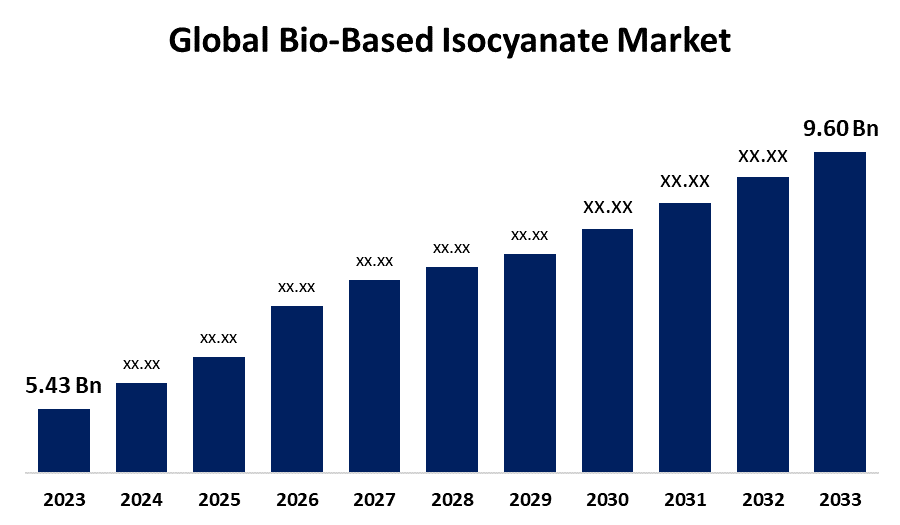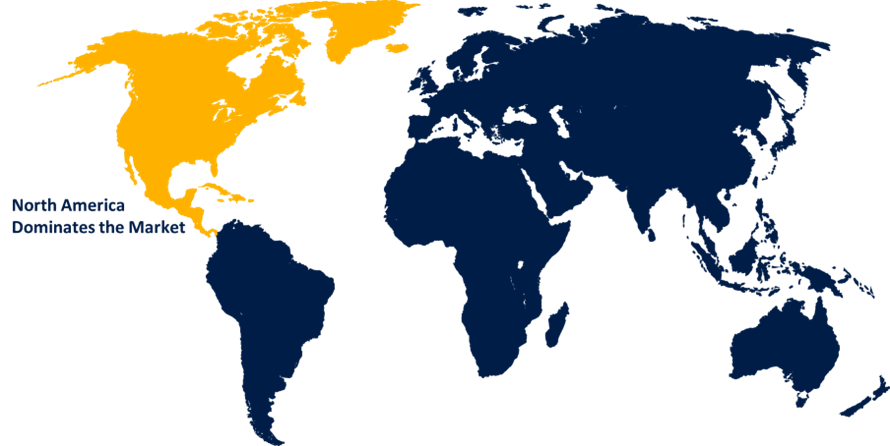Global Bio-Based Isocyanate Market Size, Share, and COVID-19 Impact Analysis By Product Type (Aliphatic and Aromatic), By Application (Foams, Adhesives & Sealants, Paints & Coatings, and Others), and By Region (North America, Europe, Asia-Pacific, Latin America, Middle East, and Africa), Analysis and Forecast 2023-2033
Industry: Chemicals & MaterialsGlobal Bio-Based Isocyanate Market Insights Forecasts to 2033
- The Global Bio-Based Isocyanate Market Size was Estimated at USD 5.43 Billion in 2023
- The Global Bio-Based Isocyanate Market Size is Expected to Grow at a CAGR of around 5.86% from 2023 to 2033
- The Worldwide Bio-Based Isocyanate Market Size is Expected to Reach USD 9.60 Billion by 2033
- Asia Pacific is Expected to Grow the fastest during the forecast period.

Get more details on this report -
The Global Bio-Based Isocyanate Market Size is Expected to Cross USD 9.60 Billion by 2033, growing at a CAGR of 5.86% from 2023 to 2033. The increasing prevalence of green construction efforts and sustainable manufacturing techniques in a variety of industries provides opportunities for producers to add bio-based products to their product lines.
Market Overview
The sector devoted to the manufacture, distribution, and usage of isocyanates sourced from renewable resources, including sugarcane and vegetable oils, is known as the "bio-based isocyanate market." These bio-based alternatives provide sustainable alternatives to traditional petrochemical-based isocyanates and are utilized in foams, coatings, adhesives, and sealants. Bio-based isocyanates are being used by sectors including construction and automotive to improve product performance and lower carbon footprints. The market for bio-based isocyanates focuses on environmentally friendly substitutes for traditional isocyanates derived from petrochemicals. Market expansion is additionally driven by industries' growing knowledge of the advantages of bio-based products, such as their improved performance and smaller environmental impact. Technological developments in bio-based chemicals and growing consumer and regulatory demand for sustainable and eco-friendly products are the primary factors driving the bio-based isocyanate market. Research institutes and industry participants are working together to create new products and applications, which is driving the bio-based isocyanate market.
Report Coverage
This research report categorizes the bio-based isocyanate market based on various segments and regions forecasts revenue growth and analyzes trends in each submarket. The report analyses the key growth drivers, opportunities, and challenges influencing the bio-based isocyanate market. Recent market developments and competitive strategies such as expansion, type launch, development, partnership, merger, and acquisition have been included to draw the competitive landscape in the market. The report strategically identifies and profiles the key market players and analyses their core competencies in each sub-segment of the bio-based isocyanate market.
Global Bio-Based Isocyanate Market Report Coverage
| Report Coverage | Details |
|---|---|
| Base Year: | 2023 |
| Market Size in 2023: | USD 5.43 Billion |
| Forecast Period: | 2023-2033 |
| Forecast Period CAGR 2023-2033 : | 5.86% |
| 2033 Value Projection: | USD 9.60 Billion |
| Historical Data for: | 2019-2022 |
| No. of Pages: | 250 |
| Tables, Charts & Figures: | 130 |
| Segments covered: | By Product Type, By Application, By Region and COVID-19 Impact Analysis. |
| Companies covered:: | BASF SE, OCI Nitrogen, Covestro AG, Huntsman Corporation, Perstorp Holding AB, Asahi Kasei Corporation, Rohm and Haas Company, Evonik Industries AG, The Dow Chemical Company, Mitsui Chemicals, Inc., Huntsman Corporation, Perstorp Holding AB, Kumho Mitsui Chemicals Inc., Tosoh Corporation, and Others. |
| Pitfalls & Challenges: | COVID-19 Empact, Challenge, Future, Growth, & Analysis |
Get more details on this report -
Driving Factors
The bio-based isocyanate market is largely driven by the increased focus on lowering dependency on non-renewable resources. Growing consumer demand for environmentally friendly products, particularly in industries like building, packaging, and automobiles, has driven the use of bio-based isocyanates. Growing awareness of environmental issues and the expanding use of sustainable materials across a range of industries, such as packaging, building, and the automotive sector, are the main drivers of the rapid expansion. The growing need for environmentally safe and sustainable chemicals is one of the primary factors driving the bio-based isocyanate market.
Restraining Factors
The high production costs of bio-based isocyanates are one of the main challenges. Moreover, the cost and scalability of manufacturing may be further impacted by the restricted availability of feedstocks and raw materials for the synthesis of bio-based isocyanates.
Market Segmentation
The bio-based isocyanate market share is classified into product type and application.
- The aliphatic segment held the largest share in 2023 and is expected to grow at a significant CAGR during the forecast period.
Based on the product type, the bio-based isocyanate market is divided into aliphatic and aromatic. Among these, the aliphatic segment held the largest share in 2023 and is expected to grow at a significant CAGR during the forecast period. The manufacturing of paints, adhesives, and elastomers frequently uses aliphatic isocyanates, especially in outdoor and automotive applications where exposure to sunshine and inclement weather is frequent.
- The paints & coatings segment held the largest share in 2023 and is expected to grow at a significant CAGR during the forecast period.
Based on the application, the bio-based isocyanate market is divided into foams, adhesives & sealants, paints & coatings, and others. Among these, the paints & coatings segment held the largest share in 2023 and is expected to grow at a significant CAGR during the forecast period. The performance of paints and coatings has improved due to developments in bio-based isocyanate technology, which has made them a competitive alternative to conventional products by increasing their adhesion, durability, and chemical resistance.
Regional Segment Analysis of the Bio-Based Isocyanate Market
- North America (U.S., Canada, Mexico)
- Europe (Germany, France, U.K., Italy, Spain, Rest of Europe)
- Asia-Pacific (China, Japan, India, Rest of APAC)
- South America (Brazil and the Rest of South America)
- The Middle East and Africa (UAE, South Africa, Rest of MEA)
North America is anticipated to hold the largest share of the bio-based isocyanate market over the predicted timeframe.

Get more details on this report -
North America is anticipated to hold the largest share of the bio-based isocyanate market over the predicted timeframe. The growing need for sustainable solutions across industries and increased environmental consciousness are the main drivers of the North America region. North American governments and regulatory agencies are also enforcing strict environmental regulations to cut emissions and phase out petroleum-based chemicals, which is fostering a climate that is conducive to the development of bio-based isocyanates. Bio-based components, such as isocyanates, are becoming increasingly popular as companies and consumers alike strive to lessen their carbon impact.
Asia Pacific is expected to grow at the fastest CAGR growth of the bio-based isocyanate market during the forecast period. The need for sustainable and energy-efficient building materials, such as bio-based foams for insulation, is growing as more nations implement green construction programs to achieve energy conservation targets. Asia Pacific's automotive sector is also making a substantial contribution to market expansion. Large-scale infrastructure projects and urbanization have made the construction industry one of the main forces behind regional growth.
Competitive Analysis:
The report offers the appropriate analysis of the key organizations/companies involved within the bio-based isocyanate market along with a comparative evaluation primarily based on their type of offering, business overviews, geographic presence, enterprise strategies, segment market share, and SWOT analysis. The report also provides an elaborative analysis focusing on the current news and developments of the companies, which includes type development, innovations, joint ventures, partnerships, mergers & acquisitions, strategic alliances, and others. This allows for the evaluation of the overall competition within the market.
List of Key Companies
- BASF SE
- OCI Nitrogen
- Covestro AG
- Huntsman Corporation
- Perstorp Holding AB
- Asahi Kasei Corporation
- Rohm and Haas Company
- Evonik Industries AG
- The Dow Chemical Company
- Mitsui Chemicals, Inc.
- Huntsman Corporation
- Perstorp Holding AB
- Kumho Mitsui Chemicals Inc.
- Tosoh Corporation
- Others
Key Target Audience
- Market Players
- Investors
- End-users
- Government Authorities
- Consulting And Research Firm
- Venture capitalists
- Value-Added Resellers (VARs)
Market Segment
This study forecasts revenue at global, regional, and country levels from 2023 to 2033. Spherical Insights has segmented the bio-based isocyanate market based on the below-mentioned segments:
Global Bio-Based Isocyanate Market, By Product Type
- Aliphatic
- Aromatic
Global Bio-Based Isocyanate Market, By Application
- Foams
- Adhesives & Sealants
- Paints & Coatings
- Others
Global Bio-Based Isocyanate Market, By Regional Analysis
- North America
- US
- Canada
- Mexico
- Europe
- Germany
- UK
- France
- Italy
- Spain
- Russia
- Rest of Europe
- Asia Pacific
- China
- Japan
- India
- South Korea
- Australia
- Rest of Asia Pacific
- South America
- Brazil
- Argentina
- Rest of South America
- Middle East & Africa
- UAE
- Saudi Arabia
- Qatar
- South Africa
- Rest of the Middle East & Africa
Frequently Asked Questions (FAQ)
-
1. What is the CAGR of the bio-based isocyanate market over the forecast period?The bio-based isocyanate market is projected to expand at a CAGR of 5.86% during the forecast period.
-
2. What is the market size of the bio-based isocyanate market?The Global Bio-Based Isocyanate Market Size is Expected to Grow from USD 5.43 Billion in 2023 to USD 9.60 Billion by 2033, at a CAGR of 5.86% during the forecast period 2023-2033.
-
3. Which region holds the largest share of the bio-based isocyanate market?North America is anticipated to hold the largest share of the bio-based isocyanate market over the predicted timeframe.
Need help to buy this report?